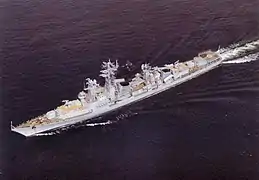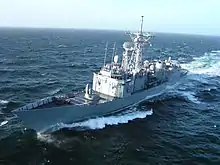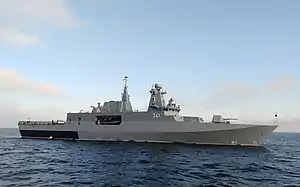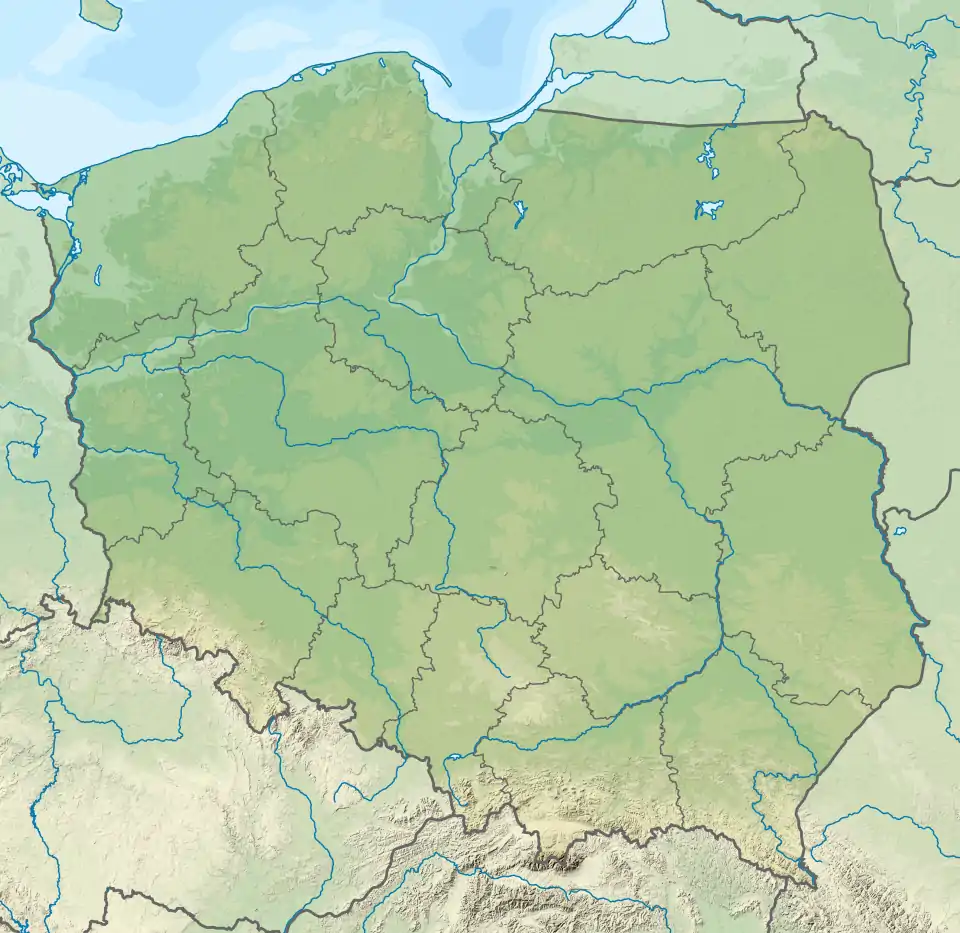Polish Navy
The Polish Navy (Polish: Marynarka Wojenna, "War Navy"; often abbreviated to Marynarka) is a military branch of the Polish Armed Forces responsible for naval operations. The Polish Navy consists of 48 ships and about 12,000 commissioned and enlisted personnel. The traditional ship prefix in the Polish Navy is ORP (Okręt Rzeczypospolitej Polskiej, "Vessel of the Republic of Poland").
| Polish Navy | |
|---|---|
| Marynarka Wojenna | |
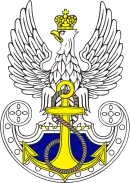 | |
| Founded | 24 March 1568 (Sea Commission) 1626 (Commission of Royal Ships) 1918 (Polish Navy) |
| Country | |
| Branch | Navy |
| Size | 12,600 military (2016)[1] |
| Part of | Polish Armed Forces |
| Headquarters | Gdynia |
| Engagements | Standing NRF Maritime Group 1 Iraq War |
| Commanders | |
| Chief of the General Staff | gen. broni Rajmund Andrzejczak |
| General Commander | gen. broni Jarosław Mika |
| Inspector of the Navy | wadm. Jarosław Ziemiański |
| Insignia | |
| Flag |  |
| Naval Ensign |  |
| Naval Jack | 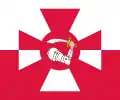 |
Origins
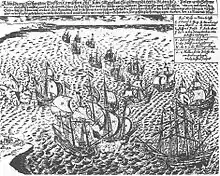
The Polish Navy has its roots in naval vessels that were largely employed on Poland's main rivers in defense of trade and commerce. During the Thirteen Years' War (1454–66), a small force of ships that primarily operated on rivers and lakes saw real open sea battles for the first time. At the Battle of Vistula Lagoon, a combined Polish-Prussian fleet decisively defeated the navy Teutonic Knights, and secured permanent access to the Baltic Sea. Thanks to the Second Peace of Thorn (1466), Poland acquired the maritime city of Danzig, and with it the means of maintaining a large fleet on the Baltic. In 1561, following a victory over a Russian fleet in the Baltic, the Polish Navy acquired a second key port at Riga, in modern-day Latvia.
At that time, as the Kingdom of Poland and the Grand Duchy of Lithuania became involved in conflicts in Livonia, Polish king Sigismund II Augustus organized a Sea Commission (Komisja Morska) which operated between 1568 and 1572, and supported the operations of Polish privateers, but that met with opposition of the Poland's primary port, Gdańsk (Danzig), which saw them as a threat to its trade operations (see Hanseatic League).[2] This led to the development of a privateer port in Puck.[2] Around the start of the 17th century, Poland became ruled by the House of Vasa, and was involved in a series of wars with Sweden (see also dominium maris baltici).[2] The Polish kings of the period attempted to create a proper naval fleet, but their attempts met with repeated failures, due to lack of funds in the royal treasury (Polish nobility saw little need for the fleet and refused to raise taxes for its construction, and Gdańsk continued its opposition to the idea of a royal fleet).[2] During the reign of Sigismund III of Poland, the most celebrated victory of the Commonwealth Navy took place at the Battle of Oliwa in 1627 against the Swedish Empire, during the Polish–Swedish War. The victory over the Swedish fleet secured for Poland permanent access to the Baltic, and laid the foundations for potential expeditions beyond Europe. The plans for the permanent naval fleet fell through shortly afterwards due to a badly executed alliance with the Habsburgs who in 1629 forcibly took over the fleet.[2]
The Commission of Royal Ships (Komisja Okrętów Królewskich) was created in 1625. This commission, along with the ultimate allocation of funds by the Sejm in 1637, created a permanent Commonwealth Navy. Władysław IV Vasa, Sigismund's son and successor who took the throne in 1632, purchased 12 ships and built a dedicated port for the royal navy called Władysławowo.[2] The fleet, however, was entirely destroyed in 1637 by Denmark-Norway, despite the Danish not issuing a formal declaration of war.[3] Support for the idea of a Polish-Lithuanian navy was weak and it largely withered away by the 1640s; the remaining ships were sold in the years 1641–1643, which marked the end of the Commonwealth Navy.[2] A small navy was also created by Augustus II the Strong in 1700 during the Great Northern War.[4] The Polish–Lithuanian Commonwealth, though the dominant force in Central and Eastern Europe during the 16th–18th centuries, never developed its navy to its full potential. The proportionally small Polish coastline and the limited access to the Atlantic never allowed for a massive buildup of naval forces to the level of maritime great powers such as the Kingdom of Great Britain and the Kingdom of France. The Partitions of Poland at the end of the 18th century brought an end to the possibility of an independent Polish Navy.
20th century
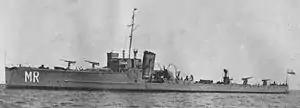
Following World War I, the Second Polish Republic on 28 November 1918, by the order of Józef Piłsudski, commander of the Armed Forces of Poland, founded the modern Polish Navy. The small naval force was placed under the command of Captain Bogumił Nowotny as its first chief. The first ships, which included several torpedo boats, were acquired from the former Imperial German Navy.
In the 1920s and 1930s the Polish Navy underwent a modernisation program under the leadership of Vice-Admiral Jerzy Świrski (Chief of Naval Staff) and Rear-Admiral Józef Unrug (CO of the Fleet). A number of modern ships were built in France, the Netherlands, and the United Kingdom. Despite ambitious plans (including 2 cruisers and 12 destroyers), the budgetary limitations placed on the government by the Great Depression never allowed the navy to expand beyond a small Baltic force. The building of one submarine, ORP Orzeł, was partly funded by a public collection. One of main goals of the Polish Navy was to protect the Polish coast against the Soviet Baltic Fleet, therefore it put emphasis on fast submarines, large and heavily armed destroyers and mine warfare. By September 1939 the Polish Navy consisted of 5 submarines, 4 destroyers, big minelayer and various smaller support vessels and mine-warfare ships. This force was no match for the larger Kriegsmarine, and so a strategy of harassment and indirect engagement was implemented.
World War II
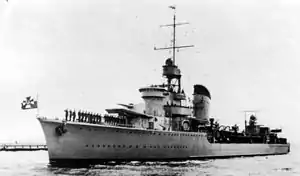
The outbreak of World War II caught the Polish Navy in a state of expansion. Lacking numerical superiority, Polish Naval commanders decided to withdraw main surface ships to Great Britain to join the Allied war effort and prevent them from being destroyed in a closed Baltic (the Peking Plan). On 30 August 1939, three destroyers, (ORP Błyskawica, ORP Grom, and ORP Burza) sailed to the British naval base at Leith in Scotland. They then operated in combination with Royal Navy vessels against Germany. Also two submarines managed to flee from the Baltic Sea through the Danish straits to Great Britain during the Polish September Campaign (one of them, ORP Orzeł, made a daring escape from internment in Tallinn, Estonia, and traveled without charts). Three submarines were interned in Sweden, while remaining surface vessels were sunk by German aircraft.
During the war the Polish Navy in exile was supplemented with leased British ships, including two cruisers (HMS Danae/ORP Conrad, and HMS Dragon/ORP Dragon), seven destroyers, three submarines, and a number of smaller fast-attack vessels. The Polish Navy fought alongside the Allied navies in Norway, the North Sea, the Atlantic and the Mediterranean, and aided in the escort of Atlantic and Arctic convoys, in which ORP Orkan was lost in 1943. Polish naval vessels played a part in the sinking of the German battleship Bismarck, and in the landings in Normandy during D-Day. During the course of the war, one cruiser, four destroyers, one minelayer, one torpedo boat, two submarines and some smaller vessels (gunboats, mine hunters etc.) were sunk; in total, twenty-six ships were lost, mostly in September 1939. In addition to participating in the sinking of Bismarck, the Polish Navy sank an enemy destroyer and six other surface ships, two submarines and a number of merchant vessels.
Postwar
After World War II, on 7 July 1945, the new Soviet-imposed Communist government revived the Polish Navy with headquarters in Gdynia. During the Communist period, Poland's navy experienced a great buildup, including the development of a separate amphibious force of Polish Marines. The Navy also acquired a number of Soviet-made ships, including 2 destroyers, 2 missile destroyers, 13 submarines and 17 missile boats. Among them was a Kilo-class submarine, ORP Orzeł and a modified Kashin-class missile destroyer, (ORP Warszawa). Polish shipyards produced mostly landing craft, minesweepers and auxiliary vessels. The primary role of the Warsaw Pact Polish Navy was to be Baltic Sea control, as well as amphibious operations along the entire Baltic coastline against NATO forces in Denmark and West Germany. The collapse of the Soviet Union, the dissolution of the Warsaw Pact, and the fall of Communism ended this stance.
21st century
Poland's entrance into the North Atlantic Treaty Organization has greatly changed the structure and role of the Polish Navy. Whereas before, most of Naval High Command was concerned with coastal defense and Baltic Sea Operations, the current mindset is for integration with international naval operations. The focus is on expansion of subsurface naval capabilities, and in the creation of a large submarine force. To facilitate these changes the Republic of Poland has undertaken a number of modernization programs aimed at creating a force capable of power projection around the world. This includes a number of foreign acquisitions, including the acquisition of four Kobben-class submarines from Norway, and two Oliver Hazard Perry-class frigates from the United States. The Polish Navy has also one Kilo-class submarine (ORP Orzeł). The Naval air arm has also acquired a number of SH-2G Super Seasprite helicopters. Highly appreciated is a naval commando unit Formoza (since 2007 part of the Wojska Specjalne).
.jpg.webp)
The Polish Navy has taken part in numerous joint force operations. In 1999 the naval base at Gdynia became the home base of all NATO submarine forces in the Baltic, codenamed "Cooperative Poseidon". That same year joint American-Polish submarine training manoeuvres codenamed "Baltic Porpoise" for the first time utilized the port in a multinational military exercise.
Modernization
The Polish Navy is undergoing a full modernization. Initially planned as a 9 billion zloty project, the budget was reduced to 5 billion zloty in 2012 which caused projects delays or cancellations over the allotted time 2010 – 2018.[5] The latest strategy for the navy considers larger warships as unsuitable for the Baltic Sea, however one Oliver Hazard Perry-class frigate will be upgraded to extend its operation life beyond 2020. 12 new ships worth around 10 billion PLN were to be acquired before 2026. The plan was updated in 2017 for 2013–2022 period to be worth 13 billion zloty and call to acquire 22 new vessels.[6] This include three Coastal Defence Vessel, code name Miecznik with displacement of 2600 tons, three patrol/mine countermeasure vessel, code name Czapla with 1700 tons displacement.[7][8] Three new submarines are planned with delivery expected in 2024–2025. Three Kormoran 2-class minehunters are planned.[9][10]
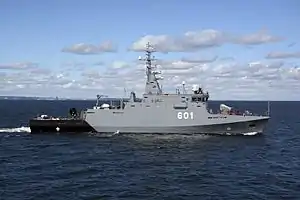
Other purchases include six tugboats, two tankers, two rescue ships, one ELINT, one logistical support ship and one Joint Support Ship. However some deliveries are expected up to 2026.[6] Meanwhile, to reduce costs, serving vessels will be upgraded and overhauled to maintain operational status. Concerns have been risen about the Polish Navy, as more vessels are being withdrawn from service without being replaced in the near future.[11][12] With the increased tension in the area surrounding Poland, plans have been put in place to potentially procure up to three new submarines with cruise missile launch capability. The cruise missiles carried are planned to have an 800 km (500 mi) range.[13]
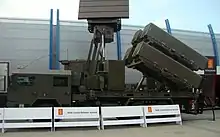
The Polish Navy has already acquired 36 Swedish RBS15 Mk3.[14] and 50 (50/74) Norwegian Naval Strike Missiles[15] for vessels and coastal defence units. It is planned to reinforce the Navy's helicopter fleet with four to eight ASW/SAR units.[16] The Gawron-class corvettes program was cancelled with the sole surviving unit to be built as a patrol vessel.[5] On 2 July 2015 ORP Ślązak was christened during official launching ceremony, becoming the first new Polish-built Navy ship in 21 years.[17] In June 2013 the Coastal Missile Division (NDR) equipped initially with 12 Naval Strike Missiles and two TRS-15C radars achieved initial readiness.[18]
Mission and organization
The main mission of the Polish Navy is the defense of Poland's territorial waters, coastline and its interests abroad. Other missions include the support of NATO allied operations, and search and rescue operations throughout the Baltic Sea. In addition, the Polish Navy supplies nearly 40 ships as part of the NATO Rapid Reaction Force, designed to be a force projection and conflict response force around the world. The Polish Navy is organized into 2 separate Flotillas and a Naval Air Brigade.[19] Until January 1, 2014 the service had a Chief of the Navy (a three-star Admirał floty) and a Naval Command. On that date the branch-specific Land Forces, Air Forces, Naval and Special Forces Commands were disestablished and combined into two new commands. The functions of the three-star Chief of the Navy were split between two two-star officers (vice-admirals in the Polish system of military ranks) - an Inspector of the Navy under the Armed Forces General Command, responsible for manpower, materiel and combat readiness and a Commander of the Seaborne Component Command, responsible for naval operations.
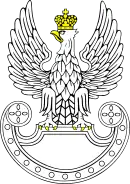 |
| Polish Armed Forces |
|---|
| Branches |
|
|
| History |
|
Timeline Wars |
| Personnel |
|
Senior officers Rank insignia Awards Oaths |
| Equipment |
|
Land Forces Navy |
- Armed Forces Operational Command in Warsaw
- Seaborne Operations Center - Seaborne Component Command in Gdynia
- Armed Forces General Command in Warsaw
- Inspector of the Navy in Warsaw[20]
- 3rd Ships Flotilla "Commodore Bolesław Romanowski" in Gdynia-Oksywie
- Flotilla Command
- Submarine Ships Division in Gdynia-Oksywie
- ORP 291 Orzeł - Kilo-class submarine
- ORP 295 Sęp and ORP 296 Bielik - Kobben-class submarines
- Gdynia Combatant Ships Division - Gdynia-Oksywie
- ORP 272 Generał Kazimierz Pułaski and ORP 273 Generał Tadeusz Kościuszko - Oliver Hazard Perry-class frigates
- ORP 421 Orkan, ORP 422 Piorun and ORP 423 Grom - Orkan-class missile corvettes
- ORP 240 Kaszub - single ship ASW corvette Project 620
- ORP 241 Ślązak - single ship multirole corvette Project Meko A-100, being fitted out until the end of 2018
- Support Ships Division in Gdynia
- ORP 251 Wodnik - single ship Wodnik-class training vessel Project 888
- ORP 281 Piast and ORP 282 Lech - Piast-class rescue-salvage ships Project 570
- ORP R-14 Zbyszko and ORP R-15 Maćko - rescue cutters Project B823
- Reconnaissance Ships Group in Gdynia
- ORP 262 Nawigator and ORP 263 Hydrograf - Nawigator-class reconnaissance ships
- Hydrographic Support Squadron in Gdynia
- ORP 265 Heweliusz and ORP 266 Arctowski - Heweliusz-class hydrographic survey ships
- ORP 253 Iskra - Iskra-class sail training ship
- 2 hydrographic cutters K-4 and K-10 and 3 hydrographic motor launches M-38, M-39 and M-40
- Coastal ASM Unit "Commodore Zbigniew Przybyszewski" in Siemirowice
- 1st Coastal ASM Division - Naval Strike Missile
- 2nd Coastal ASM Division - Naval Strike Missile
- 9th Anti-Aircraft Division in Ustka - Grom MANPADS and S-60 AAA guns
- 43rd Naval Combat Engineer Battalion in Rozewie
- Naval Technical Base in Gdynia
- Military Port Command "Brig. Gen. Stanisław Dąbek" in Gdynia
- Base Location Hel
- Naval Sailing Training Center in Gdynia
- Naval Control and Measurement Range in Gdynia-Oksywie
- ORP H34 Błyskawica - Grom-class destroyer museum ship
- 8th Coastal Defense Flotilla "Vice admiral Kazimierz Porębski" in Świnoujście
- Flotilla Command
- 2nd Landing and Minelaying Ships Division in Swinoujscie
- ORP 821 Lublin, ORP 822 Gniezno, ORP 823 Kraków, ORP 824 Poznań and ORP 825 Toruń - Lublin-class minelayer-landing ships
- ORP 511 Kontradmirał Xawery Czernicki - multirole support ship
- 3 landing cutters Project 716
- 12th Wolin Minesweeper Division in Swinoujscie
- 13th Minesweeper Division "Fleet Admiral Andrzej Karweta" in Gdynia
- ORP 624 Czajka - minehunter Project 206FM
- ORP 601 Kormoran - minehunter Project 258
- ORP 630 Gopło, ORP 643 Mamry, ORP 644 Wigry, ORP 645 Śniardwy, ORP 646 Wdzydze - coastal minesweepers Project 207M
- EOD Diver Group
- 8th Anti-Aircraft Division in Dziwnów - Grom MANPADS, ZU-23-2 and S-60 AAA guns
- 8th Kołobrzeg Naval Combat Engineer Battalion in Dziwnów
- Military Port Command Swinoujscie
- Base Location Kołobrzeg
- Gdynia Naval Aviation Brigade "Commander Pilot Karol Trzask-Durski"[21] in Gdynia-Babie Doły
- Brigade Command
- 43rd Oksywie Naval Air Base "Commander Edward Stanisław Szystowiski" in Gdynia-Babie Doły
- Air Group
- 4 transport aircraft An-28TD (0703 and 1003) and M28B (1117 and 1118)
- 4 shipborne ASW helicopters Kaman SH-2G Super Seasprite (3543, 3544, 3545 and 3546)
- 6 SAR helicopters W-3WARM Anakonda (0505, 0506, 0511, 0813, 0815 and 0906)
- 2 training and liaison helicopters Mi-2D (5245) and Mi-2R (5348)
- Air Group
- 44th Kaszubian-Darłowo Naval Air Base in Siemirowice
- Kaszubian Air Group in Siemirowice
- 7 maritime patrol aircraft M28B-1R Bryza M28B-1R (1006, 1008, 1017, 1022, 1114, 1115 and 1116)
- 1 maritime patrol and submarine detection aircraft M28B-1RM/BIS Bryza (0810)
- 2 environmental monitoring aircraft An-28E (0404 and 0405)
- Darłowo Air Group in Darłowo
- Kaszubian Air Group in Siemirowice
- Naval Hydrographical Bureau in Gdynia
- 6th Oliwa EW Center "Admiral Arend Dickmann" in Gdynia
- Naval Training Center "Vice Admiral Józef Unrug" in Ustka
- Naval NCO School in Ustka
- Diving and Deep Diving Training Center of the Polish Armed Forces "Commodore Stanisław Mielczarek" in Gdynia
- 3rd Ships Flotilla "Commodore Bolesław Romanowski" in Gdynia-Oksywie
- Inspector of the Navy in Warsaw[20]
Ranks and insignia
Commissioned ranks
| NATO Code | OF-9 | OF-8 | OF-7 | OF-6 | OF-5 | OF-4 | OF-3 | OF-2 | OF-1 | |
|---|---|---|---|---|---|---|---|---|---|---|
Navy |
||||||||||
| Polish name | Admirał | Admirał floty1 | Wiceadmirał | Kontradmirał | Komandor | Komandor porucznik |
Komandor podporucznik |
Kapitan marynarki |
Porucznik marynarki |
Podporucznik marynarki |
| Abbreviation | adm. | adm.fl. | wadm. | kadm. | kmdr | kmdr por. | kmdr ppor. | kpt.mar. | por.mar. | ppor.mar. |
| U.S./U.K. equivalent | Admiral | Vice Admiral |
Rear Admiral |
Rear Admiral (lower half)/ Commodore |
Captain | Commander | Lieutenant Commander |
Lieutenant | Lieutenant (junior grade)/ Sub-lieutenant |
Ensign |
|
1 introduced in 2002 | ||||||||||
Petty Officers and Seamen ranks
| NATO Code | OR-9 | OR-8 | OR-7 | OR-6 | OR-5 | OR-4 | OR-3 | OR-2 | OR-1 | ||
|---|---|---|---|---|---|---|---|---|---|---|---|
Navy |
|||||||||||
| Polish name | Starszy chorąży sztabowy marynarki |
Starszy chorąży marynarki |
Chorąży marynarki |
Młodszy chorąży marynarki |
Starszy bosman |
Bosman | Bosmanmat | Starszy mat |
Mat | Starszy marynarz |
Marynarz |
| Abbreviation | st.chor.szt.mar. | st.chor.mar. | chor.mar. | mł.chor.mar. | st.bsm. | bsm. | bsmt | st.mat | mat | st.mar. | mar. |
| U.S./U.K. equivalent | Command Master Chief Petty Officer |
Master Chief Petty Officer |
Senior Chief Petty Officer |
Chief Petty Officer |
Petty Officer First Class |
Petty Officer Second Class |
Petty Officer Third Class |
Petty Officer Third Class, Leading Seaman |
Seaman | Seaman Apprentice |
Seaman Recruit |
Ships and naval aircraft
Ships
.jpg.webp)

.jpg.webp)
Currently, the Polish Navy operates 48 ships, including: 3 submarines, 2 frigates, 2 corvettes, 3 fast-attack craft, 21 mine destroyers, 5 mine layers, 4 salvage ships, 6 auxiliary ships and 2 training vessels. Also, the navy operates 40 naval aircraft, including 10 maritime patrol planes, 4 transport planes, 10 search air-rescue helicopters, 12 anti-submarine warfare helicopters, 4 transport & training helicopters.
Aircraft
| Aircraft | Origin | Type | Variant | In service[22] | Notes |
|---|---|---|---|---|---|
| PZL M28 Bryza | Transport Ecological monitoring Reconnaissance patrol |
Bryza 1TD Bryza 1E Bryza 1R / 1RM Bis |
4 2 8 |
[22] | |
| Mil Mi-2 | Transport and training | Mi-2D Mi-2R |
3 1 |
[23] | |
| Mil Mi-14 | ASW SAR |
Mi-14PŁ Mi-14PŁ/R |
8 2 |
||
| AgustaWestland AW101 | ASW/SAR | 4 on order[24] | |||
| SH-2G Super Seasprite | ASW | SH-2G | 4 | ||
| PZL W-3 Anakonda | SAR | W-3WARM | 8 | 2 W-3T and 6 W-3RM upgraded to W-3WARM[25] |
See also
Notes
- "Archived copy". Archived from the original on 2010-10-11. Retrieved 2011-01-12.CS1 maint: archived copy as title (link)
- Juliusz Bardach, Boguslaw Lesnodorski, and Michal Pietrzak, Historia panstwa i prawa polskiego (Warsaw: Paristwowe Wydawnictwo Naukowe), 1987, p.231
- Michael Roberts (27 April 1984). The Swedish Imperial Experience 1560–1718. Cambridge University Press. pp. 16–17. ISBN 978-0-521-27889-8. Archived from the original on 30 May 2016. Retrieved 7 June 2011.
- Jerzy Pertek Polacy na morzach i oceanach: Do roku 1795, p. 176
- "Rozczarowujące BME 2010". Altair. Archived from the original on 2012-03-13. Retrieved 2012-04-17.
- Nowy harmonogram modernizacji MW RP. Archived 2017-02-02 at the Wayback Machine Altair, January 20th, 2017. (in Polish)
- The Polish Navy Development Concept. Archived 2017-03-05 at the Wayback Machine amberexpo.pl
- Miecznik i Czapla częściowo odtajnione. Archived 2013-07-15 at the Wayback Machine Altair (in Polish)
- TECHNICAL MODERNIZATION PLAN FOR ARMED FORCES in the years 2013–2022. Archived 2013-01-18 at the Wayback Machine (in Polish)
- "Polish Navy to Acquire New Submarine". Defense News. Retrieved 14 December 2014.
- "Gawron na wodzie". Altair. Archived from the original on 2012-03-13. Retrieved 2012-04-17.
- "ORP Pułaski – pływający złom". Altair. Archived from the original on 2012-03-13. Retrieved 2012-04-17.
- "Rakiety dla samolotów, okrętów i wyrzutni naziemnych. Polska armia ostrzy kły". TVN24.pl. Archived from the original on 3 December 2014. Retrieved 14 December 2014.
- "RBS15 Mk 3 Surface to Surface Missile SSM in use". Saab Group. Archived from the original on October 24, 2010.
- "defence.professionals". defpro.com. Archived from the original on 2012-06-30. Retrieved 2012-04-17.
- "Poland evaluates three bids for helicopter acquisition". Archived from the original on 2017-04-09. Retrieved 2017-04-08.
- Defence Minister: We need to expand Polish Navy. Archived 2017-10-04 at the Wayback Machine 02.07.2015
- "Ukompletowanie NDR". Altair. Archived from the original on 2015-07-03.
- "Polish Navy". Archived from the original on 18 December 2014. Retrieved 14 December 2014.
- "Marynarka Wojenna". www.jednostki-wojskowe.pl. Archived from the original on 2018-09-26. Retrieved 2018-09-26.
- Rydzyk|2012|www.rczpi.wp.mil.pl, made by RCZPI|design by Patryk. "..:: :: Jednostki ::." blmw.wp.mil.pl (in Polish). Archived from the original on 2018-09-26. Retrieved 2018-09-26.
- "Wyposażenie". Wojsko-Polskie.pl (in Polish). Retrieved 2019-12-11.
- "Śmiglowiec transportowy Mi-2". Wojsko-Polskie.pl (in Polish). Retrieved 2019-12-11.
- Perry, Donald (26 April 2019). "Poland orders four AW101 helicopters for navy". Flightglobal. Retrieved 26 April 2019.
- "Śmigłowiec poszukiwawczo - ratowniczy W-3WARM Anakonda". Wojsko-Polskie.pl (in Polish). Retrieved 2019-12-08.
Bibliography
- Nelcarz, Bartolomiej & Peczkowski, Robert (2001). White Eagles: The Aircraft, Men and Operations of the Polish Air Force 1918–1939. Ottringham, UK: Hikoki Publications. ISBN 1-902109-73-2.
- Peszke, Michael Alfred, Poland's Navy: 1918–1945, New York, Hippocrene Books, 1999, ISBN 0-7818-0672-0.
